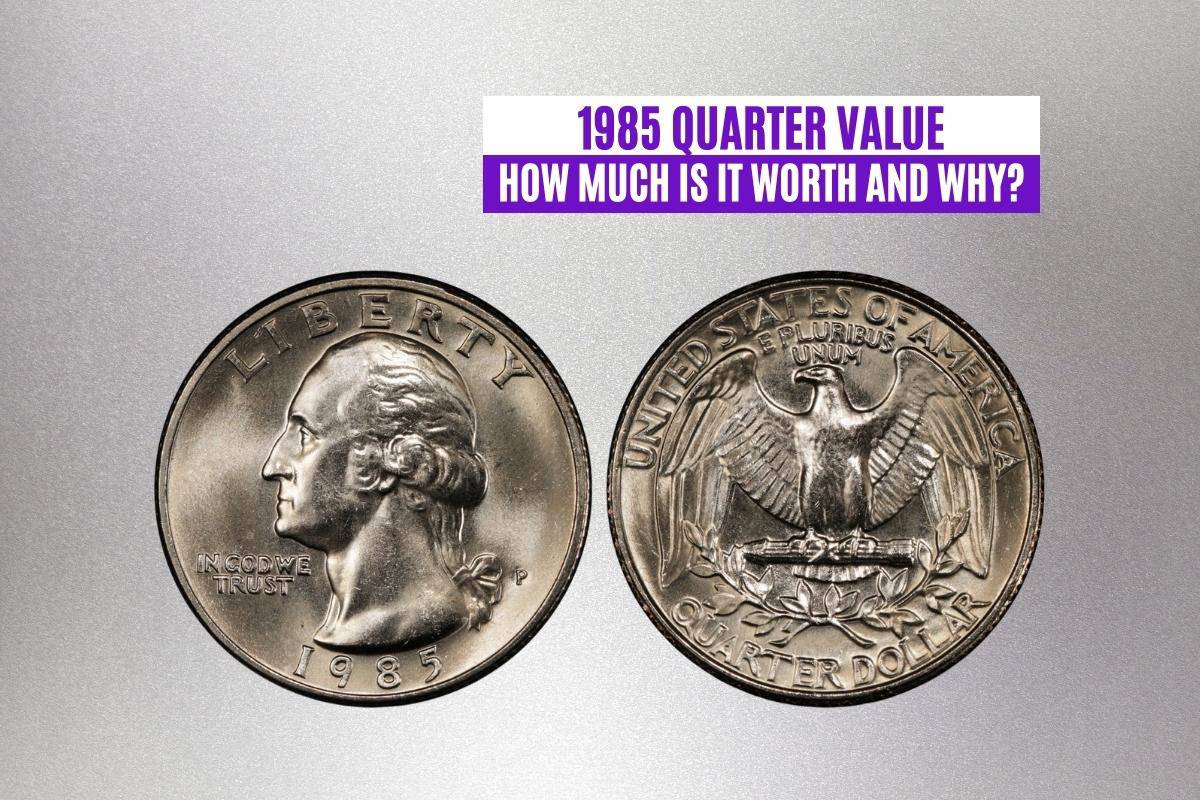Almost every coin becomes more valuable over time, but some older coins are worth more than others. This begs the question: Just how valuable is the 1985 quarter?
The 1985 quarter value varies significantly. Although many of these twenty-five-cent coins have enjoyed heavy circulation (making them worth exactly $0.25), others have been fortunate enough to remain in exceptional condition over the years, allowing them to become quite valuable.
This guide will explore everything you need to know about the 1985 Washington quarter, ensuring you invest in and sell this coin for the best possible prices!
1985 Washington Quarter Value Chart
| Regular Strike | MS-65 | MS-66 | MS-67 |
| 1985-P Quarter | $1 | $22 | $550 |
| 1985-D Quarter | $1 | $22 | $650 |
| Proof Strike | PR-68 | PR-69 | PR-70 |
| 1985-S Proof Quarter | $7 | $8 | $20 |
1985 Washington Quarter: History
Did you know that the quarter dollar coin is actually one of the newer additions to the U.S. coinage system? The U.S. Mint was striking one-cent pennies and five-cent nickels before 1795, but it wouldn’t be until 1796 that the quarter joined the party.
Since then, it’s been a staple denomination within the U.S. monetary system. But it hasn’t always looked like it does today.
Like other denominations, the quarter coin has undergone several changes over the last few centuries. In addition to design changes, this coin has changed metal compositions, most notably from silver to copper.
But in 1980, the quarter saw another change: the addition of a “P” mint mark. Before this point, quarters struck at the Philadelphia Mint had no mint mark (hence their colloquial name, “No Mint Mark” quarters).
Still, the 1985 Washington quarter shares quite a lot in common with quarters that came before it. The most obvious similarity is the design, as the 1985 Washington quarter design is almost identical to the original Washington quarter design implemented in 1932.
1985 Washington Quarter: Design
The design for the 1985 Washington quarter was created by a sculptor named John Flanagan.
Flanagan created this design in the early 1930s, though the image of Washington is based on a much older source. In fact, the face-in-profile version of George Washington seen in Flanagan’s design is based on a bust created while Washington was still alive!
And although some design elements of the 1932 Washington quarter changed by 1985 (such as the placement of the mint mark), the Washington quarter design remained virtually unchanged until the late 1990s.
1985 Washington Quarter Obverse
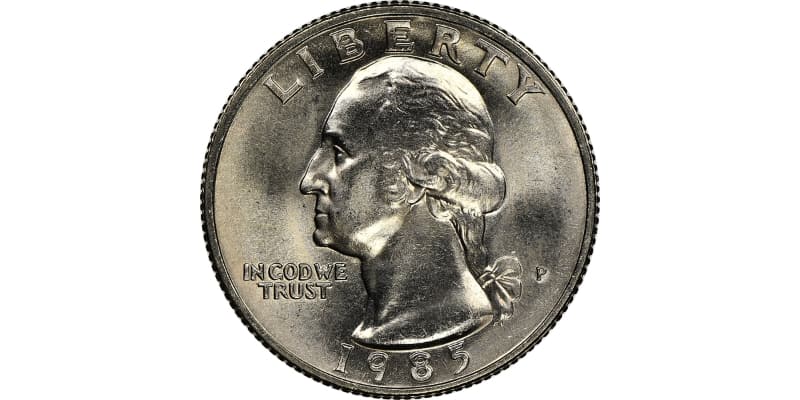
The obverse (front) side of the 1985 Washington quarter shows:
- At the bottom of the coin, the year date (1985)
- In the center of the coin, the device (raised image) of George Washington’s face in profile, facing left
- At the top of the coin, the legend “LIBERTY” (above Washington’s head)
- At the bottom left of the coin (beneath Washington’s chin), the motto “IN GOD WE TRUST”
- At the bottom right of the coin (behind Washington’s hair tie), the mint mark (P, D, or S)
1985 Washington Quarter Reverse
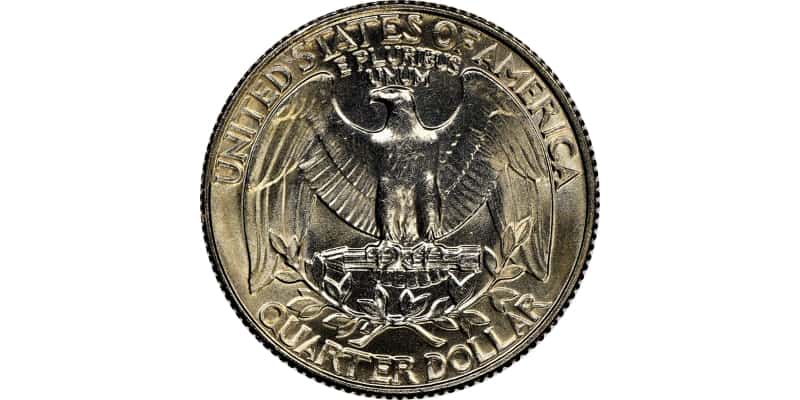
The reverse (back) side of the 1985 Washington quarter shows:
- At the bottom of the coin, the coin denomination “QUARTER DOLLAR”
- In the center of the coin, the device (raised image) of a perched eagle above an olive branch, wings outstretched
- At the top of the coin, the issuing nation “UNITED STATES OF AMERICA”
- Above the eagle’s head, the motto “E PLURIBUS UNUM” (Latin, “Out of many, one”)
1985 Washington Quarter: Features and Specifications
Although 1985 Washington quarters are available in three primary varieties (1985-P, 1985-D, and 1985-S), there are a handful of characteristics that all quarters struck in 1985 share.
For example, all 1985 quarters:
- Have a mint mark
- Weigh about 0.2 ounces (5.67 grams)
- Are about 0.96 inches (24.3 millimeters) in diameter
- Are made of 25% nickel and 75% copper
- Have reeded (grooved) edges
But although these traits unify 1985 Washington quarters in several ways, this coin’s value is highly variable.
To determine just how much one of the quarters is worth, you’ll need to consider coin condition (PCGS or NGC grade), rarity (via mintage numbers), and strike type (regular versus proof).
How Much Is a 1985 Washington Quarter Worth?
According to Greysheet, a 1985-P Washington quarter in circulated condition is worth $0.25. It can be worth $0.35 to $550 or more in uncirculated condition (MS-60 grade or higher).
1985 Washington Quarter: Value Comparison
A heavily circulated regular-strike 1985 Washington quarter is worth exactly what you’d expect; $0.25! That said, some 1985 Washington quarters are worth hundreds of dollars.
The defining factors impacting the value of these coins include:
- Coin condition (PCGS or NGC grade)
- Coin rarity
- Coin strike type
For example, the average proof-strike 1985-S Washington quarter is more valuable than a regular-strike quarter in good or about uncirculated condition. But the most valuable 1985 Washington quarters aren’t proof strike coins; they’re regular-strike pieces.
Without further ado, let’s dive into the values of the 1985 Washington quarter to discover which of these twenty-five-cent coins are the most valuable of the bunch.
1985-P Washington Quarter Value
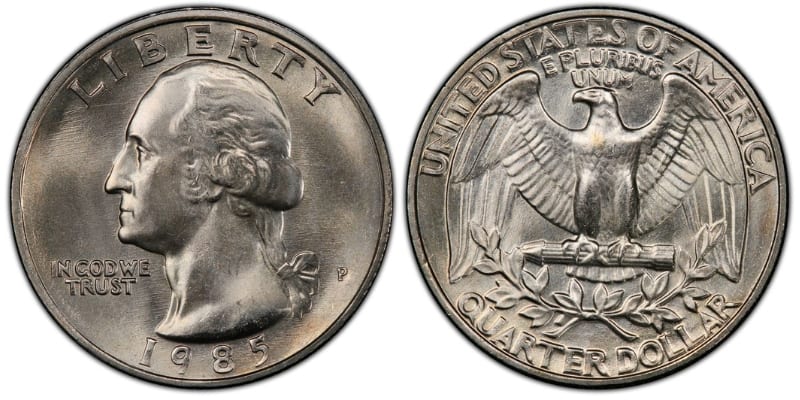
Do you have a 1985 quarter with a small “P” mint mark? If so, you have one of the 1985-P Washington quarters.
These quarters were struck at the Philadelphia Mint, and they’re the most common type of quarter from 1985. The Philadelphia Mint struck over 775 million quarters in 1985, about 35% of which still exist today.
A 1985-P Washington quarter is worth $0.25 in good condition (G-4) and about uncirculated condition (AU-50), making it just as valuable as brand-new regular-strike quarters struck today. But in uncirculated condition (MS-60 grade or higher), the 1985-P quarter is more valuable.
For example, an MS-60 1985-P Washington quarter has an estimated worth of about $0.35, while an MS-67 can sell for $550 or more. That’s more than 2,000 times the original value of this coin!
With that said, the 1985-P Washington quarter is more common than the 1985-D Washington quarter. As a result, 1985 quarters struck at the Philadelphia Mint tend to be slightly less valuable than those struck at the Denver Mint.
1985-D Washington Quarter Value
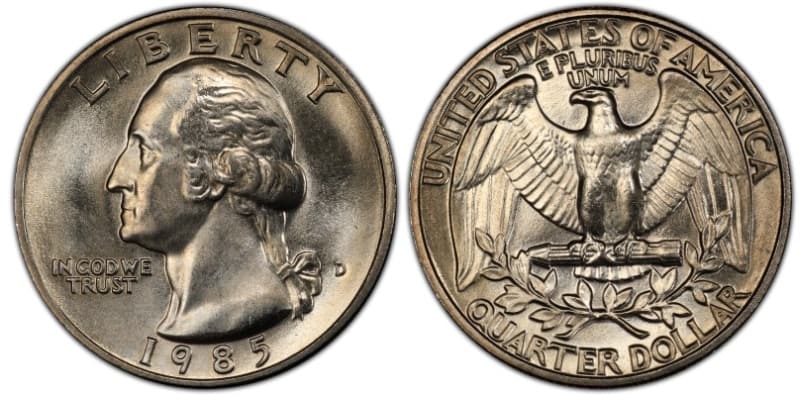
The Denver Mint struck slightly fewer quarters than the Philadelphia Mint in 1985, with a mintage total of just under 520 million quarters. Because it’s slightly harder to find than the 1985-P Washington quarter, the 1985-D Washington quarter is generally a little more valuable, particularly in uncirculated condition.
A 1985-D Washington quarter is only worth about $0.25 in good (G-4) and about uncirculated (AU-50) condition. Like the 1985-P quarter, an MS-60 1985-D Washington quarter is worth about $0.35.
But an MS-67 1985-D Washington quarter has an estimated value of $650, making it worth $100 more than an identically-graded 1985-P quarter. This higher value is entirely attributable to rarity and coin condition.
1985-S Proof Washington Quarter Value
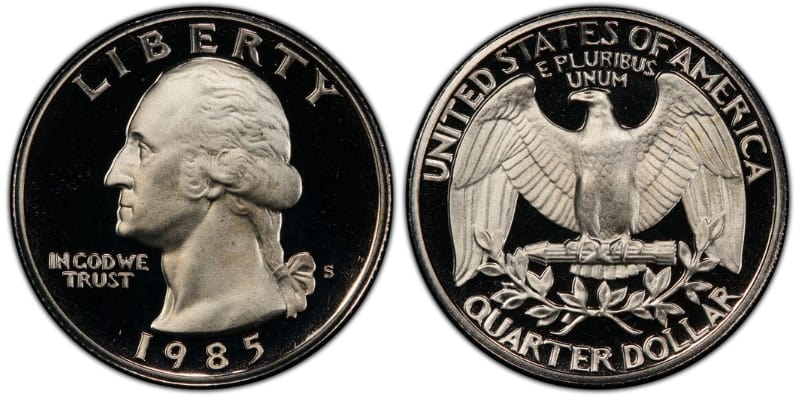
The San Francisco Mint was the only U.S. Mint facility to produce proof-strike quarters in 1985. This facility struck about 3.362 million proof quarters in 1985, all of which feature a small “S” mint mark on their obverse faces.
These quarters exhibit the Deep Cameo (also called Ultra Cameo) effect. This effect makes proof quarters easily distinguishable, as they have an almost two-tone look, with a dark background (field) and brighter raised images and text.
But although 1985-S Washington quarters might be more aesthetically pleasing thanks to their Deep Cameo finish, they’re less valuable than top-tier mint-state 1985-P and 1985-D Washington quarters.
A PR-70 1985-S Washington quarter is only worth about $20, even though PR-70 is the highest possible grade a proof-strike coin can earn. For a more direct comparison, while MS-67 1985-D and 1985-P quarters can fetch hundreds of dollars, a PR-67 1985-S Washington quarter is only worth about $5.
This lower value can be surprising to some collectors, as the 1985-S Washington quarter is far rarer than its regular-strike counterparts. Additionally, 1985-S proof-strike quarters are all in uncirculated condition, having never entered circulation.
Still, mintage volume and coin grade aren’t the only factors to consider when determining coin value. Although the 1985-S Washington quarter might be rarer and in excellent condition, these coins were made explicitly for collectors.
Because these coins were never designed for circulation, finding one in exceptional shape isn’t challenging. The same cannot be said for high-grade 1985-P and 1985-D quarters, which is why regular-strike pieces with grades of MS-65 are often more valuable than proof-strike pieces with higher coin grades.
1985 Washington Quarter: Rare Errors
Making money is serious business, whether you’re earning it or creating it. But while the U.S. Mint strives to ensure that all coins that leave its facilities are error-free, mistakes occasionally happen.
This can be frustrating for the U.S. Mint but a boon for collectors. After all, rare error coins can be worth a pretty penny (or several thousands of dollars), making them valuable assets for any coin collection.
But what kind of error coins can you expect to find within the pool of 1985 Washington quarters? Generally, there are three errors you’ll see associated with this twenty-five-cent coin:
- Incorrect planchet errors
- Multiple strike errors
- Off-center errors
Some of these errors result in coins that are worth more than $1,000. But not all error coins are equally valuable!
To ensure you’re not overspending on rare error quarters from 1985, let’s take a closer look at the above errors and discuss:
- How they happen
- How to identify them
- How valuable they are
1985 Washington Quarter Incorrect Planchet Error
Transforming metal into ready-for-circulation coins isn’t a single-step process. Generally, the transformation starts with coin blanks, also called planchets.
These metal discs are made of specific alloys designed for each coin type. For example, modern penny planchets are copper-plated zinc, while quarter planchets are copper and nickel. These planchets become coins after being pressed between coin dies.
Coin dies are like thick metal stamps. Each die features an engraved image on its “face,” and when pressed against a metal planchet, the disc takes on that image.
Sometimes, the wrong types of planchets end up between coin dies. When this happens, you end up with an incorrect-planchet error coin.
Unfortunately for the U.S. Mint (but fortunately for collectors), quite a few quarters were struck on the wrong planchet type in 1985.
The most common type of wrong planchet for these error coins is the five-cent nickel planchet. This makes sense when you consider that the coloration of the 1985 nickel is similar to that of the quarter coin.
“Struck on a nickel planchet” error quarters from 1985 are worth between $150 and $300, depending on the coin’s condition. The best way to identify this error is to have your quarter professionally graded by a reputable coin grading service.
1985 Washington Quarter Multiple Strikes Error
When a coin doesn’t release from the coin dies after it’s struck, it can end up being struck multiple times. This type of error coin is typically easy to identify, as multiple high-pressure strikes produce coins with warped edges and amorphous shapes.
Multi-strike coins are often the most valuable of all 1985 Washington quarter error coins. For example, a 1985-P multi-strike Washington quarter sold for just shy of $1,500 in 2005, and other multi-strike 1985 quarters have sold for hundreds of dollars at auction.
1985 Washington Quarter Off-Center Error
Planchets have to be perfectly aligned between coin dies during the striking process. When they’re not, the design imparted by the coin dies ends up off-center, with part of the design missing.
Off-center coins are easy to identify thanks to the partially-missing design. The most valuable of these error coins are those that are very off-center, as represented by the off-center percentage.
For example, a 10% off-center 1985 Washington quarter might sell for $50, but an 80% off-center piece can sell for upwards of $160.
Frequently Asked Questions
Do you have additional questions about the 1985 Washington quarter? If so, check out the frequently asked questions below!
How Many 1985 Washington Quarters Exist?
The U.S. Mint struck about 1.295 billion regular-strike quarters in 1985. According to PCGS coin survival estimates, approximately 453 million of these coins exist today. That means about 35% of all regular-strike Washington quarters produced in 1985 are around today.
What’s the Rarest 1985 Washington Quarter?
The 1985-D Washington quarter is the rarest regular-strike quarter from 1985. For perspective, 1985-P quarters outnumber 1985-D quarters by about 89 million pieces.
But, overall, the rarest type of 1985 Washington quarter is the 1985-S proof-strike quarter. It’s thought that less than 3 million of these coins exist today.
What’s the Highest Amount Ever Spent on a 1985 Washington Quarter?
The highest amount ever spent at auction for a 1985 Washington quarter is $1,680. In 2013, an MS-67 1985-D Washington quarter sold on eBay for this amount. Only a handful of other 1985 Washington quarters have sold for over $1,000, though none have surpassed this auction record.
Final Thoughts
A heavily circulated 1985 Washington quarter is likely worth its listed denomination of $0.25. But if your regular-strike 1985 Washington quarter has a grade of MS-65 or higher, it could be worth far more.
The 1985 quarter value might not be as high as the value of older quarters (particularly those made of silver), but it will likely rise over time due to increased scarcity. Consequently, coin collectors and investors might want to invest in one of these coins sooner rather than later!
Are you a numismatist looking to build a better coin collection? Check out these related articles now!

